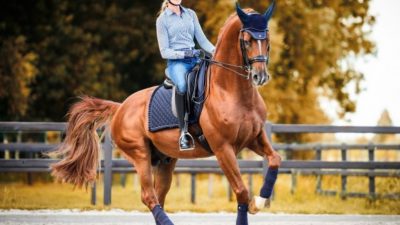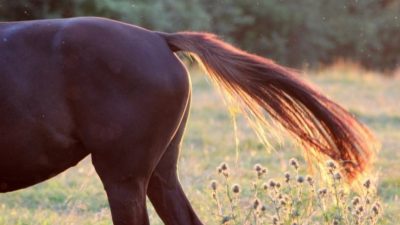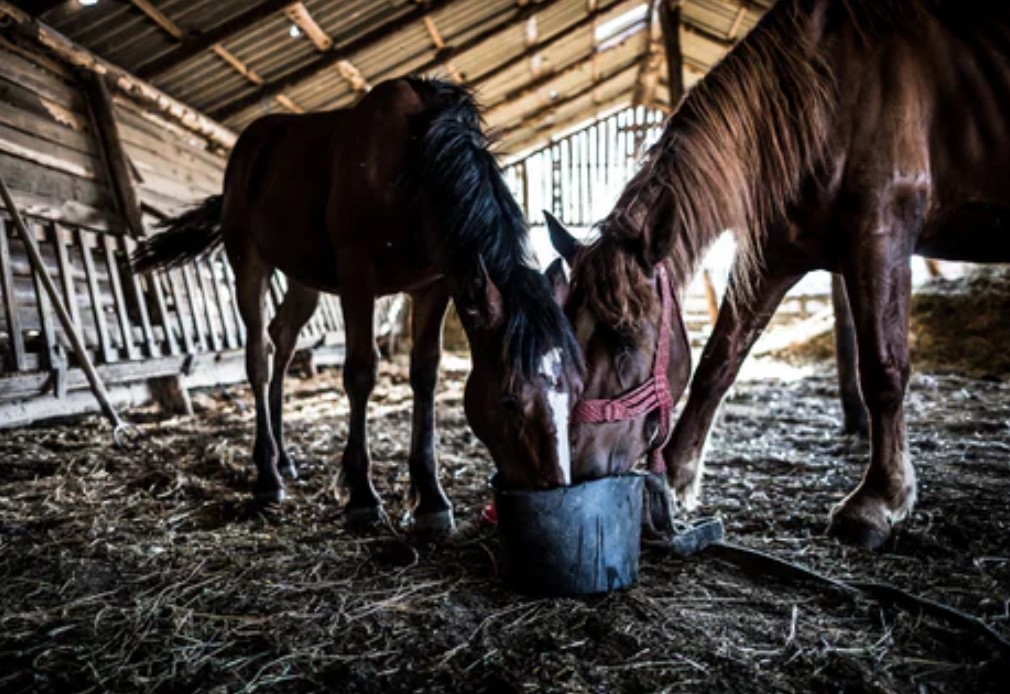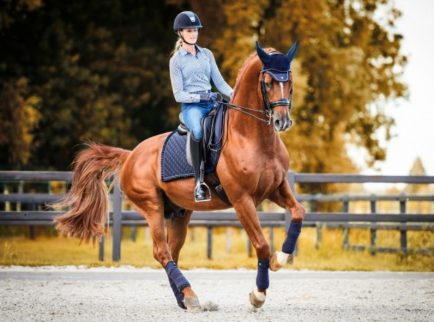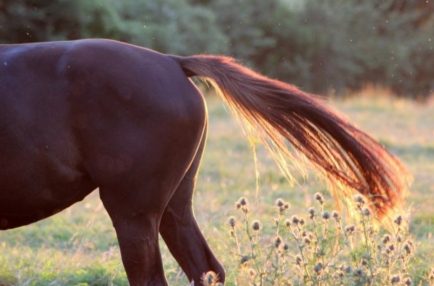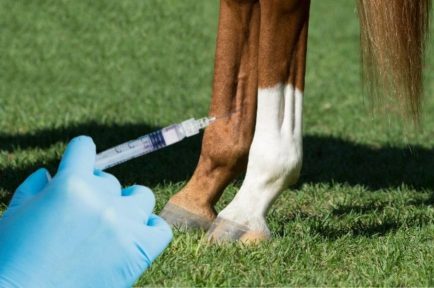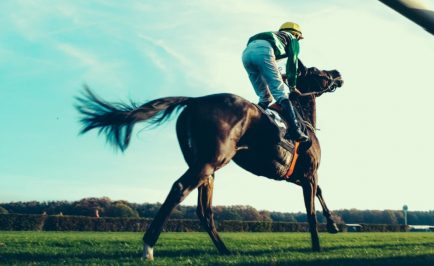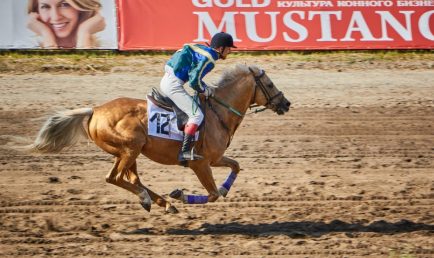Help your horse shed his excess pounds safely
When your horse started shedding this spring, did you discover beneath that long, fuzzy winter coat a hefty horse in serious need of weight loss? Obesity creates health risks for your horse, so stepping in with a weight-loss strategy is the responsible, kind, and caring thing to do. But short of installing a treadmill in your horse’s stall, what are your options?
Generally speaking, consuming fewer calories than the body burns in daily activity results in weight loss. So it follows that if your horse has put on a few too many pounds, you can either feed him less or exercise him more (or both) to bring him back to optimal weight.
However, before you slash his ration and/or ride him to kingdom come, take time to assess not only his weight and body condition but also his diet, exercise routine, and health. Then formulate a plan. Contact your veterinarian and an equine nutritionist to be sure your proposed plan is nutritionally sound, given your horse’s status and underlying health factors. Here’s how to get started.
1. Measure His Weight
The most accurate way to measure your horse’s weight-loss progress is to obtain a baseline and track the numbers over time. If you don’t have access to a suitable scale (some equine veterinary clinics and feed companies have one available), your tack or feed store likely carries weight tapes that will give you a general idea.
“I’ve found that tapes tend to estimate about 100 pounds light when used on adult horses, but they’re useful to show relative change,” says equine nutritionist Kathleen Crandell, PhD, of Kentucky Equine Research, in Versailles. “Weight tapes often aren’t big enough for larger horses such as Warmbloods or Draft Horses, so the equations that have been used to develop weight tapes can be used to estimate weight from a horse’s measurements. The most common equation is (heart girth)2 x (length from tip of shoulder to end of rump) / 330.” The Horse has a weight calculator and instructional video available at TheHorse.com/weightcalculator.
Body condition scoring (BCS) is also helpful. An up or down movement of one BCS on the 1-to-9 scale, with 9 being obese, involves 35-45 pounds, depending on the horse’s size, says Crandell, so for larger horses it will be closer to 45. “Depending on how you push the horse, expect 60 to 180 days to move down one BCS,” she says.
2. Assess His Diet
To decrease your horse’s feed intake, you must first know how much he is eating. Hay flakes can vary in size and weight, even within the same bale, so begin by weighing several of his normal meals and calculating the average.
You can do this by standing on a scale yourself to get a weight, then standing on it while carrying the hay and calculating the difference. Or, says Crandell, you can hang a bucket or hay bag or net from a dairy or fish scale, being sure to zero out the container’s weight before adding the hay. You can also use this method to weigh hay cubes and other feeds.
But weight isn’t everything. Different hays contain different amounts of nutrients and calories, so the better the hay quality, the less concentrate and supplements your horse needs to meet his nutrient requirements. For weight loss, you want a quality hay that is not too high-calorie. The best way to determine hay quality is to get samples analyzed by one of several labs around the country. If that isn’t practical, however, you can do what people have been doing for centuries: visual assessments.
“Look at the types of grasses your hay contains,” Crandell says. “Legume hays such as alfalfa will generally be higher-quality than grass hays, and cool-season perennial grasses such as timothy, orchardgrass, bluegrass, brome grass, and fescue generally make higher-quality hay than warm-season perennials like bahia and coastal Bermuda. Legume hays may be too high in calories for the purpose of weight loss.”
Crandell also recommends checking your hay’s leaf-to-stem ratio. If you see more leaf than stem, it will generally be higher in calories.
Mid- to late-maturity hay is more appropriate for obese horses than early maturity hays. “You can determine maturity a couple of different ways,” Crandell says. “For example, in timothy hay, a lot of big, tall seedheads indicate it’s pretty mature.”
If your horse is on pasture, his nutrient and calorie intake depends on both the quantity he eats and its quality. “Mature hay contains fewer calories than early cut hay, but fresh grass is 75-85% water compared to hay’s 10-12%, so the amount of fresh grass needed to obtain the same amount of dry matter (and, therefore, calories) is going to be much higher,” Crandell says.
Another difference between hay and grass, she adds, is that a horse eating hay must eat what’s in the bale, while a horse grazing on pasture can select for the tastier new growth. “So just by nature, they’ll get more calories out of the fresh grass because they’re selecting for the quality,” she explains.
If your overweight horse isn’t meeting his nutrient requirements with forage alone, you might want to add a supplementary feed to his diet to cover the shortage(s). Crandell says ration balancers, which walk the line between concentrates and supplements, are her go-to in this scenario. “They provide a vitamin, mineral, and protein balance without the extra calories of concentrates,” she says.
3. Analyze His Exercise Routine
Evaluating a horse’s exercise level can be complicated. The most accurate measure would involve a heart rate monitor to help calculate the calories burned, and you can find app-based programs that measure these figures. But absent such devices, the general rule of thumb is: The faster the gait or the steeper the incline, the more work expended and calories burned. Workout intensity matters more than workout time.
4. Assess His Health
After you’ve established that your horse needs to lose weight and you know his current diet and exercise level, have your veterinarian check him over for potential issues that could complicate a weight-loss plan.
Allergies
Horses that have seasonal or nonseasonal allergies may have specific dietary requirements, says Nimet Browne, DVM, MPH, Dipl. ACVIM, of Hagyard Equine Medical Institute, in Lexington, Kentucky. “As a result, significantly cutting calories can cause dietary imbalances,” she says. “These horses need a weight-loss plan tailored by a veterinarian or nutritionist who can closely monitor balances in trace minerals, while keeping in mind the horse’s specific allergies.”
Insulin resistance
“Weight loss in horses that are insulin resistant can be quite challenging, as this condition may result from—and can perpetuate—obesity,” says Browne. “Carbohydrate intake may be the single most important element to control in these horses.”
Formulating a dietary plan consists of identifying the horse’s goal body weight, she says, and adjusting his hay and concentrate intake to meet that goal.
“Hay analysis can be extremely important to identify the nonstructural carbohydrate component; our goal would be to feed hay that contains less than 10%,” Browne says. “Once the carbohydrate content of the hay is adjusted, then the amount of hay should be restricted (to 1.25-1.5% body weight) until the horse reaches his goal weight.
“Most horses with insulin resistance don’t need to be fed concentrate but, when cutting out grain completely, a ration balancer to provide essential nutrients and trace minerals is extremely important,” she adds.
Veterinarians have also used levothyroxine sodium powder to help heavy insulin-resistant horses drop weight.
Pituitary pars intermedia dysfunction (PPID, aka equine Cushing’s disease)
Your veterinarian can tailor a nutritional plan for your PPID horse based on his body condition and insulin status. “Horses with PPID come in many shapes and sizes,” says Browne. “Some are extremely easy keepers and would benefit from a decrease in concentrates and grass, but others are hard keepers and need to maintain a certain caloric intake to prevent weight loss.”
Lameness
Many horses with soundness issues can be managed more successfully if they aren’t carrying extra weight, says Browne. “Obesity can put additional strain on musculoskeletal structures, exacerbating preexisting issues, as well as sometimes causing new ones,” she says.
Horses with laminitis pose a unique challenge, Browne says. “Ultimately, these horses’ weight-loss programs should be aimed at understanding the cause of the laminitis and then addressing those concerns,” she says, which could include insulin resistance, PPID, obesity, or systemic disease, as well as an injury or limitation in the supporting limb.
“As all of these situations require unique approaches, these horses should be managed with close adherence to veterinarian and farrier recommendations,” Browne adds. “Generally, horses with laminitis secondary to insulin resistance and PPID can be managed similarly as described above; however, due to potential stall rest, these horses may require additional (diet) restrictions as they will not be getting exercise.”
5. Enact Your Plan
If you and your veterinarian and/or equine nutritionist change your horse’s feed type and ration, Crandell recommends doing it gradually over seven to 14 days, depending on his sensitivity to feed changes. “A general rule would be to go by quarters every other day,” she says. “For example, if you want to switch concentrate feeds, and a horse gets 4 pounds of it a day, start with 1 pound of the new mixed into 3 pounds of the old feed for two days, then 2 pounds of the new mixed into 2 pounds of the old for two days, then 3 pounds of the new mixed into 1 pound of the old for two days. Then you should be ready for 4 pounds of the new alone. For horses with more sensitive guts, either go four days after the changes in quarters or change by eighths every other day.”
If you’re transitioning to a ration balancer, “cut down the amount of the old feed to the amount of the new feed, then gradually switch over” to the balancer. Also make hay changes gradually.
Crandell lists ways to increase activity and reduce calorie intake:
Limit pasture time While this method can be effective, some horses learn how to adjust their grass intake. “In one study, once the ponies learned that they were only going to be turned out for two hours, they … were able to consume almost 1% of their body weight in forage in that period,” she says. “But horses on pasture can also get the benefit of movement, which burns calories.”
Use slow feeders These free-standing units or haynets limit the amount a horse can eat.
Add a grazing muzzle Researchers have found that muzzles can limit pasture consumption by up to 80%, says Crandell. “These are my go-to for horses with metabolic problems and easy keepers where the best thing for them is to be out on grass, but grass can be dangerous for them,” she says.
Feed a mature hay As long as it’s clean and not rained on, dusty, or moldy, horses spend more time chewing and use up more calories eating mature hay than early cut hay.
Take advantage of companionship A horse will follow his buddy around (or spend time avoiding a grumpy companion), increasing calories burned.
Spread hay over a large area Make horses walk for their hay, which mimics grazing. You can also configure a track paddock where you fence an outer and inner perimeter to create a path that encourages horses to wander all day going to the various hay piles.
(Feeder balls) work well in stalls and drylots and extend the amount of time horses eat.
Dr. Kathleen Crandell
Enlarge his living area If he’s stalled, turn your horse out in a drylot each day to maximize the energy he expends but prevent grazing.
Use your topography If you have hills on your horse property, put hay at the top of the hill, water at the bottom, and salt somewhere between so your horse burns calories moving around.
Use a feeder ball with high-fiber concentrates Also called hay replacers and hay extenders, these high-fiber, low-calorie concentrates dribble out of the feeder ball a few pellets at a time as the horse rolls it around. “These work well in stalls and drylots and extend the amount of time horses eat,” Crandell says.
Minimize blanketing In winter, doing away with blankets for unclipped horses maximizes the calories your horse expends generating body warmth.
Take-Home Message
The phrase “calories in/calories out” applies when helping your horse lose weight, but you might need to make special considerations for horses with certain conditions to help them trim down safely. Weight control is a balancing act of nutrients and exercise, so assess your horse’s weight, diet, exercise level, and health, then prepare your plan. Consult your veterinarian and equine nutritionist to be sure your horse receives the nutrients he needs while shedding those extra pounds.
Original article: 5 Steps for Equine Weight Loss – The Horse
www.royalequestriancollection.com – check our website to purchase and enjoy our products for your horses and you.










